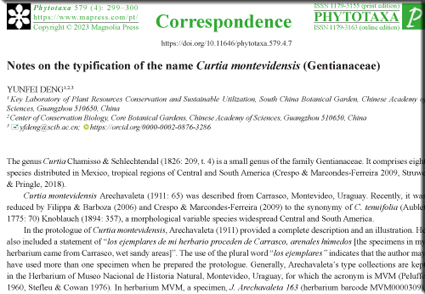Abstract
The genus Curtia Chamisso & Schlechtendal (1826: 209, t. 4) is a small genus of the family Gentianaceae. It comprises eight species distributed in Mexico, tropical regions of Central and South America (Crespo & Marcondes-Ferreira 2009, Struwe & Pringle, 2018).
References
<p>Aublet, J.B.C.F. (1775) <em>Histoire des Plantes de la Guiane Françoise </em>1. Pierre-François Didot jeune, Paris, 621 pp.</p>
<p>Arechavaleta, J. (1911) Vegetación Uruguaya. Varias espécies nuevas. <em>Anales Del Museo Nacional de Montevideo ser. 2</em> 1: 59–83.</p>
<p>Chamisso, A. & Schlechtendal, D. (1826) De plantis in expeditione speculatoria romanzoffiana observatis. <em>Linnaea </em>1: 165–226.</p>
<p>Crespo, S.R.M. & Marcondes-Ferreira, W. (2009) Revisão taxonômica do gênero <em>Curtia </em>(Gentianaceae). <em>Rodriguésia </em>60 (2): 423–444. https://doi.org/10.1590/2175-7860200960214</p>
<p>Filippa, E.M. & Barbaza, G.E. (2006) Novedades en Gentianaceae para América del Sur. <em>Sida, Contributions to Botany </em>22 (1): 129–143.</p>
<p>Gomes-Silva, F., Perez, L.M. & Alves, M. (2021) The discovery of the holotype of <em>Curtia montevidensis </em>(Gentianaceae). <em>Phytotaxa </em>527 (2): 158–160. https://doi.org/10.11646/phytotaxa.527.2.9</p>
<p>Knoblauch, E. (1894) Beiträge zur Kenntniss der Gentianaceae. <em>Botanisches Centralblatt </em>60 (11): 321–363.</p>
<p>McNeill, J. (2014) Holotype specimens and type citations: General issues<strong>. </strong><em>Taxon</em> 63 (5): 1112–1113. https://doi.org/10.12705/635.7</p>
<p>Peluffo, A. (1960) Arechavaleta: el investigador, el maestro, el hombre. <em>Anales de la Facultad de Química (Uruguay) </em>6: 7–22.</p>
<p>Stafleu, F.A. & Cowan, R.S. (1976) <em>Taxonomic Literature: A selective guide to botanical publications and collections with dates, commentaries and types</em>, vol. 1 [A–G], 2nd ed. Bohn, Scheltema & Holkema, Utrecht, 1136 pp. https://doi.org/10.5962/bhl.title.48631</p>
<p>Struwe, L. & Pringle, J.S. (2018) Gentianaceae. <em>In</em>: Kadereit, J. W. & Bittrich, V. (Eds.) <em>The Families and Genera of Vascular Plants</em>, vol. 15. Springer, pp. 453–504. https://doi.org/10.1007/978-3-319-93605-5_6</p>
<p>Turland, N.J., Wiersema, J.H., Barrie, F.R., Greuter, W., Hawksworth, D.L., Herendeen, P.S., Knapp, S., Kusber, W.-H., Li, D.-Z., Marhold, K., May, T.W., McNeill, J., Monro, A.M., Prado, J., Price, M.J. & Smith, G.F. (2018) <em>International Code of Nomenclature for algae, fungi, and plants (Shenzhen Code). </em>Regnum Vegetabile 159. Glashütten: Koeltz Botanical Books. https://doi.org/10.12705/Code.2018</p>
<p>Arechavaleta, J. (1911) Vegetación Uruguaya. Varias espécies nuevas. <em>Anales Del Museo Nacional de Montevideo ser. 2</em> 1: 59–83.</p>
<p>Chamisso, A. & Schlechtendal, D. (1826) De plantis in expeditione speculatoria romanzoffiana observatis. <em>Linnaea </em>1: 165–226.</p>
<p>Crespo, S.R.M. & Marcondes-Ferreira, W. (2009) Revisão taxonômica do gênero <em>Curtia </em>(Gentianaceae). <em>Rodriguésia </em>60 (2): 423–444. https://doi.org/10.1590/2175-7860200960214</p>
<p>Filippa, E.M. & Barbaza, G.E. (2006) Novedades en Gentianaceae para América del Sur. <em>Sida, Contributions to Botany </em>22 (1): 129–143.</p>
<p>Gomes-Silva, F., Perez, L.M. & Alves, M. (2021) The discovery of the holotype of <em>Curtia montevidensis </em>(Gentianaceae). <em>Phytotaxa </em>527 (2): 158–160. https://doi.org/10.11646/phytotaxa.527.2.9</p>
<p>Knoblauch, E. (1894) Beiträge zur Kenntniss der Gentianaceae. <em>Botanisches Centralblatt </em>60 (11): 321–363.</p>
<p>McNeill, J. (2014) Holotype specimens and type citations: General issues<strong>. </strong><em>Taxon</em> 63 (5): 1112–1113. https://doi.org/10.12705/635.7</p>
<p>Peluffo, A. (1960) Arechavaleta: el investigador, el maestro, el hombre. <em>Anales de la Facultad de Química (Uruguay) </em>6: 7–22.</p>
<p>Stafleu, F.A. & Cowan, R.S. (1976) <em>Taxonomic Literature: A selective guide to botanical publications and collections with dates, commentaries and types</em>, vol. 1 [A–G], 2nd ed. Bohn, Scheltema & Holkema, Utrecht, 1136 pp. https://doi.org/10.5962/bhl.title.48631</p>
<p>Struwe, L. & Pringle, J.S. (2018) Gentianaceae. <em>In</em>: Kadereit, J. W. & Bittrich, V. (Eds.) <em>The Families and Genera of Vascular Plants</em>, vol. 15. Springer, pp. 453–504. https://doi.org/10.1007/978-3-319-93605-5_6</p>
<p>Turland, N.J., Wiersema, J.H., Barrie, F.R., Greuter, W., Hawksworth, D.L., Herendeen, P.S., Knapp, S., Kusber, W.-H., Li, D.-Z., Marhold, K., May, T.W., McNeill, J., Monro, A.M., Prado, J., Price, M.J. & Smith, G.F. (2018) <em>International Code of Nomenclature for algae, fungi, and plants (Shenzhen Code). </em>Regnum Vegetabile 159. Glashütten: Koeltz Botanical Books. https://doi.org/10.12705/Code.2018</p>


